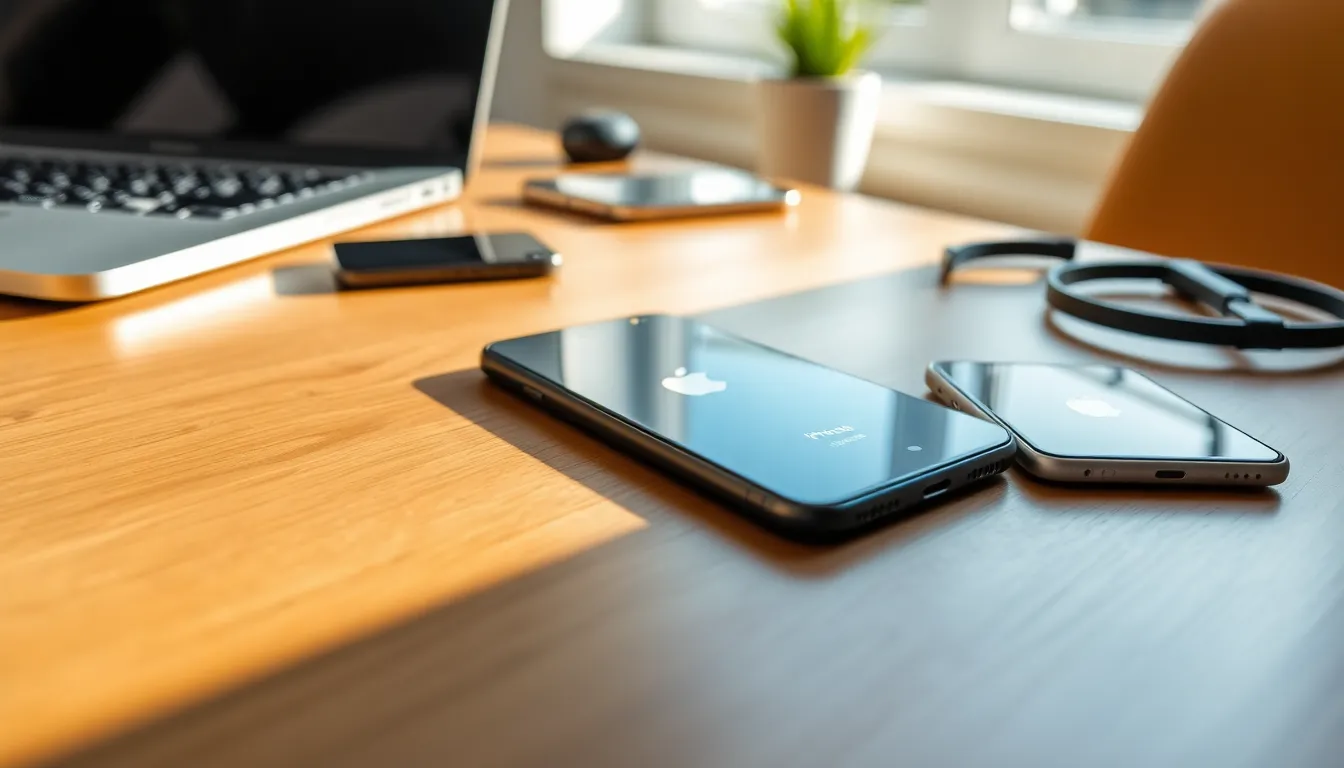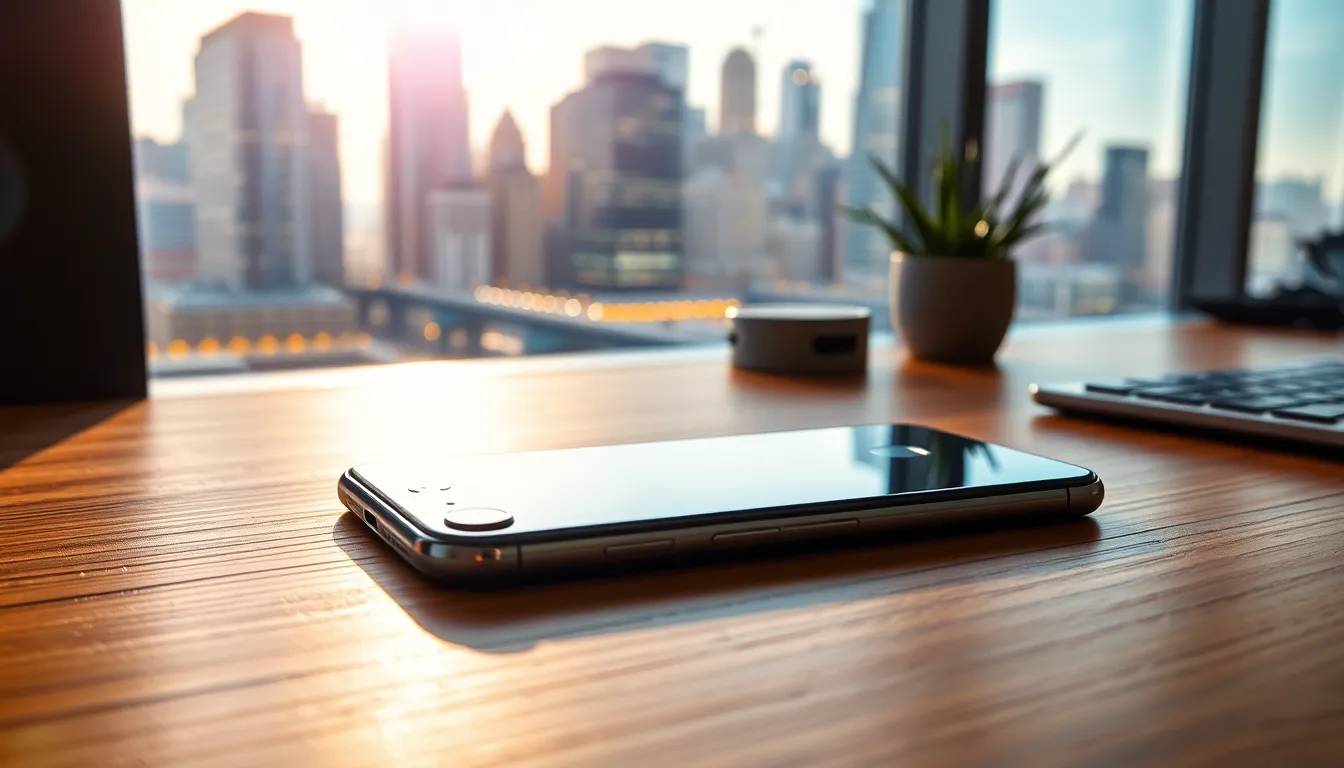Table of Contents
ToggleIn a world where 5G is the new kid on the block, everyone’s buzzing about lightning-fast downloads and streaming without buffering. But wait—what about the loyal iPhone 7 users? They might be wondering if their trusty device can keep up with the high-speed revolution or if it’s destined for the tech graveyard.
Imagine trying to surf the web on a rollercoaster while your iPhone 7 is still stuck in a slow lane. It’s a dilemma that’s got many scratching their heads and checking their upgrade options. So, can the iPhone 7 support 5G, or is it time to say goodbye to that beloved gadget? Let’s dive into the details and find out if this classic can still hang with the best of them or if it’s time to join the 5G party.
Overview of 5G Technology
5G technology represents the fifth generation of wireless communication standards. This standard offers significantly faster data speeds and lower latency compared to previous generations. Users can experience download speeds exceeding 1 Gbps, enabling quick access to apps, games, and streaming services. Moreover, 5G technology improves connectivity for multiple devices, enhancing the Internet of Things (IoT) ecosystem.
The transition to 5G supports advanced applications like autonomous vehicles and augmented reality. With its improved capacity, 5G can handle a larger number of simultaneous connections, making it essential for urban environments. Enhanced mobile broadband service plays a crucial role in creating seamless online experiences for users.
Network slicing underpins 5G’s ability to cater to diverse needs across various sectors. It allows service providers to allocate resources effectively based on application requirements. Additionally, this technology can expand coverage and reliability, making it beneficial for remote areas previously lacking adequate service.
Several key components drive the 5G network’s capabilities. Millimeter waves, small cell technology, and massive MIMO (multiple input multiple output) antennas enhance performance. As the rollout of 5G continues, many regions will experience improved network architectures, leading to better service for consumers and businesses alike.
Overall, the introduction of 5G technology marks a significant advancement in mobile connectivity. Its enhanced features pave the way for innovation and improve user experiences across a multitude of applications. Understanding these components helps users gauge the relevance and necessity of upgrading their devices in a 5G world.
iPhone 7 Specifications

The iPhone 7 features specifications that define its capabilities in the rapidly evolving smartphone landscape. Understanding these specifications provides insight into its performance and connectivity options.
Hardware Capabilities
The iPhone 7 includes Apple’s A10 Fusion chip, which delivers robust processing power. This chip allows for efficient operation of apps and features. Its maximum RAM is 2 GB, which limits multitasking efficiency compared to newer models. Moreover, iPhone 7’s LTE support includes categories up to 9, allowing for decent mobile data speeds though not enough to support 5G connectivity. Given that it lacks 5G hardware components, users seeking high-speed internet experience may encounter limitations.
Software Compatibility
Running on iOS 10 at launch, the iPhone 7 now supports updates up to iOS 15. This software version offers access to many apps and services. Despite its compatibility with more recent iOS versions, performance can lag with heavy applications. Notably, functionalities relying on 5G networks cannot operate on the iPhone 7 due to its hardware restrictions. Overall, while the software allows a degree of modern functionality, it cannot compensate for the lack of support for 5G technology.
Cellular Network Compatibility
The iPhone 7 lacks support for 5G networks, limiting its functionality in a 5G-centric environment. Understanding the differences between 4G LTE and 5G is essential for users considering their connectivity options.
4G LTE vs. 5G
4G LTE offers maximum download speeds of up to 1 Gbps, enabling users to stream videos and browse the web efficiently. In contrast, 5G can provide speeds exceeding 10 Gbps under optimal conditions, dramatically enhancing user experiences with applications requiring high bandwidth. Lower latency in 5G systems allows for quicker responses, crucial for activities like gaming and video conferencing. Devices like the iPhone 7 excel in 4G LTE use but cannot access the advanced features and speeds offered by 5G. Current technology makes 5G a game changer for multitasking and simultaneous connections among various devices.
Carrier Support
Carrier compatibility plays a significant role in accessing the latest network technologies. Major carriers across the United States are rapidly deploying 5G infrastructure and offering plans aimed at 5G-ready devices. Unfortunately, the iPhone 7 only supports 4G LTE bands and doesn’t meet the requirements for connection to 5G networks. Users of the iPhone 7 must rely on their 4G LTE capabilities, which, while functional, may lead to slower performance compared to newer smartphones designed for 5G. Adopting a 5G-capable device allows users to take full advantage of the advancements in network technology, ensuring a future-proof experience.
User Experience and Performance
User experience on the iPhone 7 hinges on its compatibility with current network technology. 5G performance provides a notable contrast to the iPhone 7’s capabilities, particularly in speed and efficiency.
Speed Tests
Speed tests reveal a significant gap between what users experience on the iPhone 7 and devices supporting 5G. While 4G LTE on the iPhone 7 can achieve speeds up to 1 Gbps, consistent testing shows real-world speeds often range between 20-50 Mbps. In contrast, 5G technology can significantly surpass 1 Gbps, hitting peak speeds exceeding 10 Gbps. This discrepancy affects streaming high-definition content and downloading large files, showcasing how 5G connectivity enhances mobile performance.
Real-World Usage
Real-world usage scenarios highlight limitations for iPhone 7 users. Engaging in activities such as online gaming or video conferencing often results in noticeable latency and buffering issues. Streaming services may struggle to deliver high-quality video without interruptions due to lower bandwidth. Users relying on 4G LTE also encounter slower download speeds, especially in congested areas where multiple users connect to the same network. In environments where 5G is available, newer devices can seamlessly manage numerous connections and support demanding applications, which the iPhone 7 cannot match.
Alternatives to iPhone 7 for 5G
Users can explore several options if they seek 5G compatibility beyond the iPhone 7. Devices like the iPhone 12 and newer models seamlessly support 5G networks and take advantage of high-speed connectivity. The iPhone 12 series features the A14 Bionic chip, enhancing speed and performance.
Samsung offers the Galaxy S21, a strong contender with excellent 5G capabilities and an advanced camera system. Featuring a stunning display, this device provides an impressive user experience with robust multitasking abilities.
Google’s Pixel 5 stands out for its software experience, delivering regular updates and excellent photography features. This smartphone supports 5G connectivity, allowing users to enjoy the benefits of the latest network technology.
For those preferring budget options, the OnePlus Nord N200 provides 5G access at an affordable price. This device includes a Snapdragon 480 processor, striking a balance between performance and value, making it suitable for users who want 5G without breaking the bank.
Additionally, the Motorola Moto G 5G is another considerable choice. It features a large display, good battery life, and 5G support, making it efficient for daily tasks and entertainment.
In the realm of flagship devices, the Galaxy Note 20 Ultra delivers exceptional performance and productivity features while supporting 5G. Its large screen and S Pen make it desirable for professionals and creatives alike.
Choosing any of these alternatives ensures users experience the capabilities of 5G without being limited by the constraints of the iPhone 7. The market offers many 5G-enabled smartphones, each catering to different needs while enhancing connectivity and performance for users.
The iPhone 7’s inability to support 5G technology poses significant limitations for users in today’s fast-evolving digital landscape. While it can manage 4G LTE connections, the performance falls short of what 5G offers. Users seeking high-speed internet and seamless connectivity for demanding applications will likely find their experience lacking on this older device.
For those who want to fully embrace the advantages of 5G, upgrading to a newer smartphone is essential. With a variety of options available in the market, users can select a device that meets their needs and budget while ensuring compatibility with the latest network advancements. Making this transition will provide a more efficient and future-proof mobile experience.





